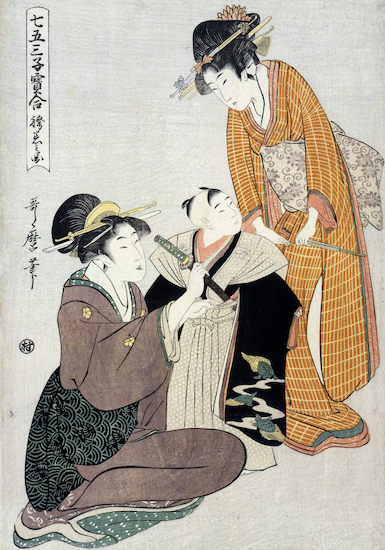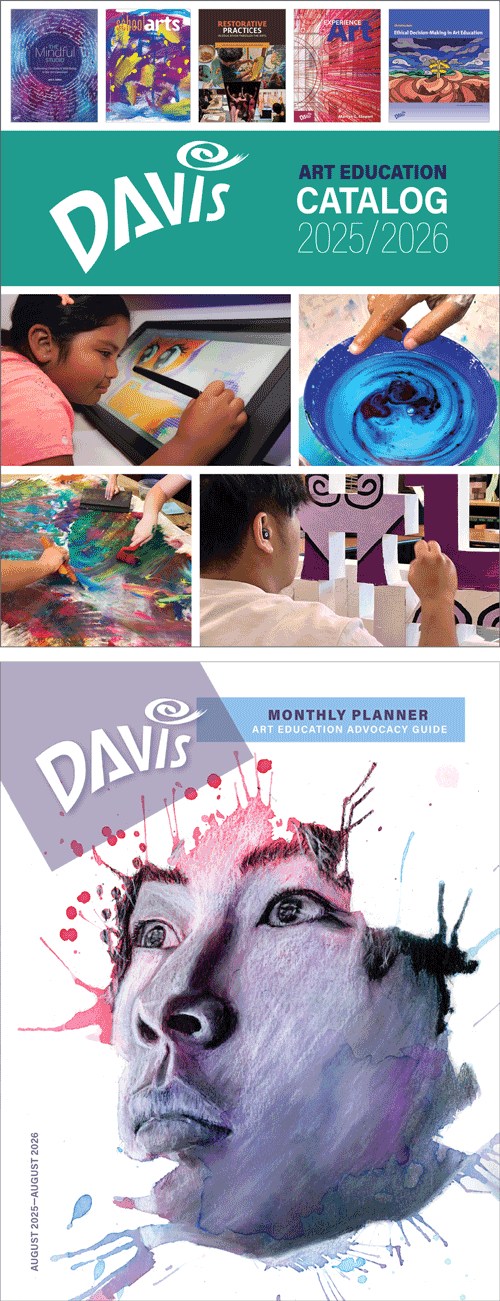The Week of Shichi-go-san: Kitagawa Utamaro
“Rites of passage” refer to cultures all over the world in which certain birthdays are celebrated as stepping stones to a new period of life. A Japanese example is Shichi-go-san. The name refers to the traditional ages of three and seven for girls and three and five for boys that are celebrated in this festival. It occurs this coming Saturday November 15th.
The Week of Shichi-go-san
 |
| Kitagawa Utamaro, Dressing a Boy on the Occasion of his First Letting his Hair Grow, 1795, color woodcut print, 15 1/2” x 10 5/8” (39.3 x 27 cm) © 2025 Brooklyn Museum (BMA-1079) |
Although much of Utamaro's subject matter was based on women in the entertainment fields, he also produced charming genre scenes. The style of the mothers and aunts in scenes such as this was, naturally, based on fashionable women in his other prints. This print celebrates the Shichi-go-san, which means "Seven, five and three." (shichi = 7, go =5, and san = 3). The festival dates from the Heian period (794-1185 CE). The celebration marks a child's survival and growth, with the three-year milestone being a time for boys (and girls). Here a mother and her maid help dress a boy as a "grown-up" in a little samurai outfit, that includes a haori jacket and hakama pants. During the festival, families visit Shinto shrines, the children dress like adults and they are gifted chitose-ame (long-life candy). The boy's kimono sleeves represent turtles, appropriately, for they symbolize longevity, wisdom, and good fortune.
Background
The Edo (or Tokugawa) Period (1615-1868) was the last period of traditional Japan. It was a time of peace, political stability and economic growth under the military dictatorship (shogunate) founded by Tokugawa Ieyasu (1543-1616). In the 1630s there was a complete ban on Christianity, an expulsion of all foreigners except a few Dutch and Chinese traders in Nagasaki, and, from 1633, a ban on foreign travel by Japanese.
The roughly 250 years of peace led to an expansion of the Japanese economy, particularly in commerce and manufacturing, which led to the development of large urban centers. The emergence of a well-to-do merchant class brought about the development of a dynamic urban culture that found expression in a particular genre of the traditional art form of woodblock printing, the Ukiyo-e style.
Ukiyo-e means "pictures of the floating world," floating in the Buddhist sense of the transience of earthly pleasures. The earthly pleasures depicted in these woodblock prints reflected the glittering entertainment districts (yoshiwara) of Japanese cities: its theaters, restaurants, bars and shops.
Eventually, however, Ukiyo-e subject matter extended into genre scenes, landscape and literary illustration. Early Ukiyo-e images were painted, but with demand high, artists turned to the woodblock medium. Initially these prints were black and white or three color. By 1764, the multiple block process (often as many as twelve for one print, with a different color printed from each block) was perfected, creating the nishiki-e or "brocade picture", so named for the wide range of colors available to an artist that resembled the colorful patterns on kimonos.
One of the most popular genre of subjects of the Ukiyo-e style was the bijin-ga, pictures of beautiful women. The bijin-ga provided images of the ideal of Japanese female beauty, as well as displaying the latest fashions and pattern combinations, and hairdos. Utamaro was one of the three masters of the beautiful women prints, along with Kiyonaga (1752-1815) and Eishi (1756-1829). These three artists perfected the tall, slender, elegant female figures that were very influential of Ukiyo-e artists of the first half of the 1800s.
Little is actually known of Utamaro's upbringing, although he is thought to have grown up in the shop of the artist Toriyama Sekien (1712-1788). Sekien had been a member of the courtly Kanō painting school who later in life turned to Ukiyo-e prints. His earliest published work was in 1775 with the cover of a Kabuki theater playbook. His early career consisted mostly of prints theater programs, actor prints and images of samurai. Until 1791 his prints of women were unremarkable. Around that time he abandoned the other subject matter to concentrate on the bijin-ga.
Utamaro's earliest series were busts of beautiful women in a format called okubi-e, “big-head prints.” Around 1793 he had perfected the languid, attenuated female figures for which he is now renowned, beginning to produce series of groups of female figures involved in various activities, seasonal activities, festivals or in scenes from famous poems or novels.
Correlation to Davis programs: Explorations in Art 2E, grade 1, 5.4, 5.8, 6.4; Explorations in Art 2E, grade 2, 2.4, 2.6; Explorations in Art 2E, grade 5, 1.8, 5.5; Explorations in Art 2E, grade 6, 1.4, 6.9; A Community Connection 2E 2.1; A Global Pursuit 2E 5.1; A Personal Journey 2E, 2.1; Experience Art 1.1, 2.1, 3.1, 7.1; Experience Printmaking pp. 72-73; Discovering Drawing 3E p. 186

Comments